Of Things Lost and Needed
Hold onto your hats and your hearts-- it's about to get chaotic
‘Neath a battlefront of warring air masses, an odd calm encompasses the greening buds and burst-open flowers of oak, the dangling samaras of maple burnt gold, and the carefree undulations of spring azure butterflies. Kneeling in hot gravel under a beating sun, my greasy fingers struggling to press an old bolt back through two drill-holes in a slapped together battery box for a solar pump, I can feel a rivulet of sweat run down my back and into my pants, right down between my butt cheeks, while the tension breaks between the boards and a very specific nut and washer combo ricochet out of my grasp and somewhere within a radius of several feet of gleaming rock. As I’ve matured, I have learned to stop kicking things when I’m frustrated, but I do cuss and walk off for a moment. I pace along the road ditch, straining my eyes for the hardware gone astray, and the pattern and structure of recent days on the farm has suddenly become apparent: I spend my waking hours looking for, caring for, reckoning with, remembering and forgetting the little things quick to disappear in the washy, stretching swards of spring grass, burgeoning leaf-tips, and hatching insect life. And at night, I worry about them all.
The flywheel of spring emergence is rolling at an ever rapid rate. While most of my post-nuclear family unit was away to get a glimpse of the total solar eclipse downstate, Sugar dropped her calf out on pasture, a few days earlier than we’d expected. The day was somewhat hot for mid-April (we’ve now had 10 consecutive hottest global months on record, as of this publication) and the wobbly little thing, wet from birth, laid down in the partial shade of the riparian edge, buzzing with hungry flies, while her mother, heavily engorged with rich colostrum nervously mooed an exhortation to arise and nurse. When it comes to animal husbandry, I generally support a philosophy of minimal human intervention— in industrial agriculture, or clinical human birth for that matter, there is a tendency toward immediate separation, of whisking the young away towards a more controlled, hygienic environment. In certain instances, this is appropriate, and if it isn’t already clear, I am not a trained birthing professional. But I have seen plenty of cows, sows, hens and nannies deliver and raise their progeny with little or no guidance in the field. The introduction of well-meaning human support is rarely warranted, so long as the weather is fine, the basic needs are available, and nothing is clearly physiologically troubling in the stock.
I stopped to watch awhile, crossed my fingers that the little calf would get up and take its first, nourishing gulps of colostrum, even nudged it towards the udder a few times, but also continued about my work until the sun was about to set for the second moment that day. It was clear that Sugar had a rather tender, swollen hind-quarter on her udder, and a fresh scratch on the opposite side. Her tension was palpable– she grew desperate for the calf to nurse, but would walk off or gently kick when the hours-old babe struggled to properly suckle. With help, I walked our herd back to the barn for the evening, anxiety looming much like the darkening horizon. The calf was a bit too weak and disoriented to move, so we carried her up the hill about a quarter mile, our shirts stained with glossy meconium. We pet Sugar and offered affirmations, we cajoled the calf with the udder which we washed up with warm water. No luck.
Ingesting colostrum is necessary for a newborn calf to develop antibodies. It ought to occur in the first hour. After about six hours, the calf may show signs of weakness, and by 12 hours the antibiotic potential of the colostrum is greatly reduced. By 24 hours, if the calf has not fed on colostrum, either fresh from the dam or freeze-dried, packaged and sold at an exorbitant rate at the feed store, the harm is irreparable. Sugar became angry. Myself as well, but I did not kick anything. We put her head in the stanchion, got kicked, and tried with little success to milk her out a bit to relieve the engorgement. With a dim headlamp I dug through our admittedly chaotic toolshed, knocking over mystery buckets and Gordian knots of mouse-chewed bailing twine, while Sugar bellowed in the stanchion and the tired calf refused to rise, in search of our emergency nursing bottle. I started a fire to heat water to sterilize the bottle as best I could, and we managed to get a pint and a half of colostrum in it. Bracing the weakened calf, we tilted her head back, pried open her mouth and squeezed the rubber nipple in– the calf would not suck. We tried again, kneeling in cow shit, our headlamps fading. We may have gotten half a pint down the calf’s throat– not nearly the half-gallon it should have consumed by the time I fell asleep, exhausted and shit-smeared on the couch at around 1 AM.
At 2 AM, the rest of my family returned, and we tried again, to no avail. I drifted off to sleep that night (perhaps four hours total) almost certain with the knowledge that the calf was likely a lost cause unless we could get up early, rig together a system to intubate the calf, and somehow win a fight with a thousand-pound cow over the nonconsensual handling of her sensitive udders for long enough to extract a gallon of colostrum. Other than shoes, I passed out fully dressed and arose in a state of doom (this bit is nothing new, actually) only to discover the calf up on all fours, clamped onto Sugar’s teat, her muzzle frothing with creamy colostrum. A relief, to say the least, if for no other reason than I had a 300 mile drive ahead of me to go pick up 250 tree seedlings that day. At a week-old, the calf is fine, and becoming a regular pain-in-the-ass, as is to be expected.
As I write this, a potentially severe storm is approaching, and the animals seem aware. Most mornings, when I mix feed rations, I usually spot somewhere between 5-8 different species of birds from near the barrels where I scoop cans of sprouted peas and ground corn into buckets of whey. Today I spied 17, their hue and cry as thunderous as hail. A pall of hazy cloud cover has rolled in with significant wind, and a handful of very important papers– orchard maps, budgets, receipts, have been blowing out of my opened bedroom window. The ticks are up and the earthworms are oddly active in spite of the dry conditions, and our stone-deaf house dog has been anxiously pacing in anticipation of the unheard tempest.
Is there still laundry on the line? Are the piles of plastic tree guards assembled at the head of the planting area secured? Will all the goats be able to fit inside their pasture shelter? Did the array of logs and bricks holding down the hoophouse plastic slide off in that gust? The worrying, fidgeting chickadees flitting branch to branch and the showers of apple blossom petals all serve to bring these questions to the forethought of my overfull, overtired brain. Sugar bellows to her little eclipse baby and tucks into the loafing shed between volleys of heavy rain drops, the robin’s nest built precariously up on a supporting post rocking slightly.
Out under the roofless frame of the outdoor kitchen we’re still building, we have constructed a temporary nursery for the aforementioned chestnut seedlings. 250 gallon-pot seedlings in all, there are enough trees to populate 10 acres of production orchard, all held within a hastily erected nest of straw bales and shade cloth and plastic sheeting. If the winds hit just right through the weak spots in the bale wall, or if we receive significant hail, the potential for damage is considerable. In the course of executing this big agroforestry project I’ve had a mantra that I try not to say out loud for fear of ridicule: Success is where opportunity meets preparedness. I’ve come to realize that this mantra precludes the occasional act-of-God type storm systems that like to crop up this time of year in the Midwest, and that for all my preparedness, the survival of these trees through this coming bout of weather all boils down to my knot tying abilities and the quality of the dollar-store plastic spring clamps holding the whole thing together. Another mantra: You can do it right, you can do it fast, and you can do it cheap, but you can’t do all three.
While not as harrowing as the night-long saga of the weak calf, renting a U-Haul to retrieve what is essentially my retirement plan and then caring for a nursery of vulnerable, top heavy trees actively leafing out through dehydrating winds, the threat of frost and the occasional escaped goat while we wait to plant at the most opportune moment has certainly weighed on me a bit, particularly when I think back on how many times in the past decade I’ve been forced to hold down roof metal threatening to go airborne in straightline winds, or have relied on a single strand of reused baling twine to hold together the very fabric of our survival, or struggled to trench out floodwater in the mud in my underwear. A batch of young pullets squeaks as they head under the cover of their small chicken tractor which each gust of wind and volley of cold rain. Out in the vibrating grasses is a world of small things to care for, from garden tools to ducklings to my kids’ homework, all swirling together and descending to earth, each thing another precious little vulnerable flower or crying babe, and each basket or bucket or pair of hands I have with which to make the vital catch over-capacity. Baskets of eggs and buckets of milk and barrels of rain and hands so full they could not possibly deliver one more of these little things to safety. This is the cruelty and chaos of spring on the farm— the hopeless prioritizing of things lost and needed.
If spring brings life and birth, it also brings a vulnerability. I have found the traces of varmint activity– shells of stolen turkey eggs, the slain and ravaged torsos of rabbit kits, and the defoliated skeletons of wild plum plundered by hatchling caterpillars, to name a few. A primary strategy for withstanding the vulnerabilities of a hungry and competitive season is reproductive vigor. The eastern cottontails pouncing over the field and through the tangled caves of bramblebush leave their burrows full of hairless kits in order to forage from time to time. A watchful fox or cat will take the opportunity to run off with what it can. So as a strategy, the rabbits breed like– well, you know. Agriculture, as it is often practiced, particularly on the subsistence / small-end of the spectrum, cannot afford such losses. A sick calf, dead trees, or a midnight raid on the turkey poults can spell considerable ruin for the farmer. Unable to accept the vulnerability of engaging in natural processes divides us from the natural order in that way.
A forty-acre field crop is more resilient than a half-acre field crop in many ways. If some deer eat at the edges, or a low-spot floods, the yield will be reduced, but there will be a useful yield, nonetheless. But a quarter acre of beans meant to sustain a family or community unit can’t withstand some casual deer-browsing or a flood event as successfully. In fact a small gang of eastern-cottontails can pretty much decimate it under the proper circumstances.
This past week, in addition to the new arrivals of both calf and trees, we’ve also seen our first clutch of ducklings successfully hatch. The Muscovy ducks that we raise seem to be a largely resilient crop– they can meet most of their needs by foraging, the mother hens have excellent instincts for raising the young ones, and they reproduce copiously, sometimes caring for nearly 20 ducklings at a time. What most often happens is that the hen starts a nest somewhere, we may or may not know precisely where, she disappears awhile, and provided she doesn’t become dinner to a fox, she returns with her neat line of babies following behind. The clutch in question emerged somewhat like this, but with one duckling adorned with particularly large, watery eyes. It didn’t take too long to figure out that this duckling was blind, but basically able to keep up with the others– on the first day at least.
Amidst the bustle of spring and its requisite plantings, pasture rotations, dairying, construction, repair, calculation and exhaustion, an imperfect duckling requiring human intervention is an admittedly unwelcome proposition. In an average year, we raise between 50-70 ducks for meat, and if we value our own labor, they basically break even unless we work harder and make value-added products. But I’m a softy, sometimes, and I don’t tend to look at helpless ducklings and immediately make calculated economic judgments. And so, I reasoned, if this duckling can mostly keep up with its kin, and it isn’t suffering, why not keep it?
The first few days, this one duckling with an estimated street value of $10-25 net, did mostly fine. The mother, a sharper economist and judge of potential duckling value than I, didn’t outright reject it. She just did what a hen duck with a clutch of babies does: bring the ducklings to feed and forage, keep them warm from time to time in her quilt of downy breast feathers, and protect them from potential harm. Sometimes, the group would wander off, and the blind duck would do its best to locate them by sound, which is easier on the still days when you can hear clearly. It would bump into a few obstructions, but outside of needing to help it find everyone else once or twice a day, I’d invested very little labor in keeping this duckling with the group.
As the clutch quickly developed and gained speed, the blind one (AKA Big Eyed Bobby, Barnabus, Big Eyed Betty, Baby Big Eyes, etc….) got left behind more and more frequently. It starting taking five or ten minutes to locate it, sometimes sitting silently across the road, other times hung up on the chicken wire garden fence, often just chilling in a puddle or behind a grass clump, oblivious to the surrounding environment of potential peril. The canny and economically efficient farmer would have probably culled this duckling then and there, if not sooner. But despite having killed hundreds of ducks at this point in my life, it turns out that I’m a little bit tenderhearted. Sometimes.
Late in the week I had another work party related to the chestnut planting– a couple hours of hauling materials out to the site and further mapping. I’d already spent the morning off farm purchasing a water tank and otherwise liquidating my tax return, and it took me close to a half-hour to locate the duckling between events. Before I left for the field, I considered sticking the duck in my pocket or stashing it in a box somewhere, but I was somewhat overcome with the fatalism of non-intervention. I’d managed to locate the duckling every single time it was lost thus far, and figured it would be no exception when I returned in the afternoon. Charged with the responsibility of keeping the trees alive and working towards that meeting place between preparedness and opportunity, still reeling from the calf drama, overwhelmed with a lengthening task list written in finer and finer script, I headed out.
First thing I did upon return was check all the usual places I’d expect to find it… not in the garden, or under the outhouse, or near the puddle, or along the nettle-entwined fence, or among the trash and debris of our main walkway. I listened, but could only hear howling wind, argumentative cardinals, and the increased thrashing of gale-tossed tree limbs. I did yard work, any type that required kneeling close to the earth. Nothing. A storm blew in and we got a shower of pea-sized hail. I heard no duckling peeping. The air got cold, the sun dropped, and that was it.
Farming in general, and animal husbandry in particular, is composed of many lost causes and small things that we cannot afford to lose track of. In the quarter mile trip it takes to get our milking machine from the barn to the kitchen for washing and dairying, important specialty bolts and gaskets will sometimes jostle out of the cart. On a warm day, half an hour before rain, I am at a loss for where the bag of lettuce seeds has gone to. Fitting little wires into a charge controller I am unable to find that tiny little flathead screwdriver, the only one that will work. I have left an untold amount of sharpening stones in tall grass, not to mention fence pliers. But none of these things can feel abandonment, or fear, or anguish. I haven’t found the duckling since, not alive nor dead, and I can only hope that it was taken swiftly by the sluggish barred owl that perches on the oak near our house, or perhaps by some cat. Predation is as good a death as any, and better than some.
It’s morel mushroom season, or at least starting up, but as I’ve previously stated, I don’t much have the time to search for things I might find. While the act of foraging is meditative in its own right, I personally prefer to be guaranteed a meal if I go out to get bitten by ticks and scratched up by brambles– or at least a glimpse of a yellow-throated vireo. Nowadays, I just tell folks who might be interested in doing their own mushroom hunting when I think the time may be right, but I like to throw a lie or two in there, to keep things exciting. Perhaps it’s when the lilacs bloom, or when the maypops emerge, or when the oak leaves are the size of a squirrel’s ear. Days in the lower 70’s and nights in the 50’s are ideal conditions for morels to pop up. Look for elm, ash, maple… especially recently killed specimens. In other words, go where the ticks are. And just how big is a squirrel’s ear anyhow? Any time I do have the opportunity to forage, I am rewarded even if I return with no quarry. There is something essentially human in wandering about, in search of small and precious things.
With little time to forage for the finer things, I keep my senses focused on the work at hand. I peen my scythe blade, cut loads of stinging nettle for drying, look out at the height and condition of grasses and plot the springtime ambulations of swine herds while silently invoking Anthony of Padua, straining my ear when I hear the cry of distressed goat kids or worried turkey hens setting eggs ‘neath the thorny cover of the woodland edge. I rifle through parts drawers for the appropriate bulkhead adapters for plumbing an irrigation tank. The past couple of weeks have involved more plumbing than I’d ever hoped to perform– between my unfortunate and typically male attempt to fix a pond dam spigot that left us with a disembodied eight foot section of pipe and a temporary geyser, to locking together graduated PVC fittings with cement like some Russian doll made of pipe. My dad always told me the only things I needed to understand about plumbing are that hot is on the left, cold is on the right, the boss is an asshole and payday’s on Friday, but I’m beginning to understand that a reasonable grasp of thread pitch, feet of head, and pressure per square inch will get me a bit further, along with all the countless little doo-dads, bits and bobs I’ve squirreled away in dusty cans and old boxes that we used to have somewhere around here.
The storm front has now passed— precipitation was light, while winds remain considerable, but all things considered there were no loose sheets of roof metal sent aloft on raging gales like aerial guillotines, or baseball sized hail set loose upon the raggedy little nest of tree seedlings, nor goat kids carried off in a whirligig, or most importantly, the kind of heavy, inundating rains that would further threaten to delay planting– a complex and challenging coordination including but not limited to weather conditions, machine rental availability, and the individual schedules of both a handful of cooperative members and our local co-ed service fraternity. The winds rage, and the robin’s nest built on the edge of the cow-shed post rocks and wobbles, but ultimately remains safe, for the time being.
In the stormy season of deep spring, when photosynthetic momentum advances exponentially, and long lists written in fine script are carried across the prairies on rivers of wind or torn asunder by terrestrial maelstroms of rain and hail, it is not uncommon to lose little things. And the little things do add up. By the time the worn and tired twine snaps out of the last grommet of the tarp sheltering our prizes and hopes and necessities, the little things we’ve lost can amount to some bigger problems. If I am, or we are, to hold onto our heads, not to mention our hearts, in the face of all the violent and unpredictable storms ahead, it will be due in part to our attention to all the little things that need us, our intervention, our care. So question the narrative of insignificant things– or at least question where we draw our lines on significance. The line between a single bird or insect and an entire species, one or two meadows or woodlands and a regional ecotone, one child or 30,000 people– by nature of the overwhelming work we are given as humans, we all do draw a line somewhere between these things. And I’m beginning to believe it matters where.
Checking on the tree seedlings in the aftermath of the meteorological equivalent of a wet fart, they’re maybe leaning a bit roughly, but not in any concerning way. A funnel cloud has passed near here, but not touched the earth. Disaster is averted, this hour. The gang of birds silenced by the brief but dramatic weather return to performing their rackety, clamorous cacophony. I keep an eye up on the clearing sky to our west and the fearsome anvil-shaped cloud mass to our north and east– a sheer mountain of indifferent atmospheric power, and out the corner of my eye, a very specific nut and washer combo drops out of the cuff of my pants.


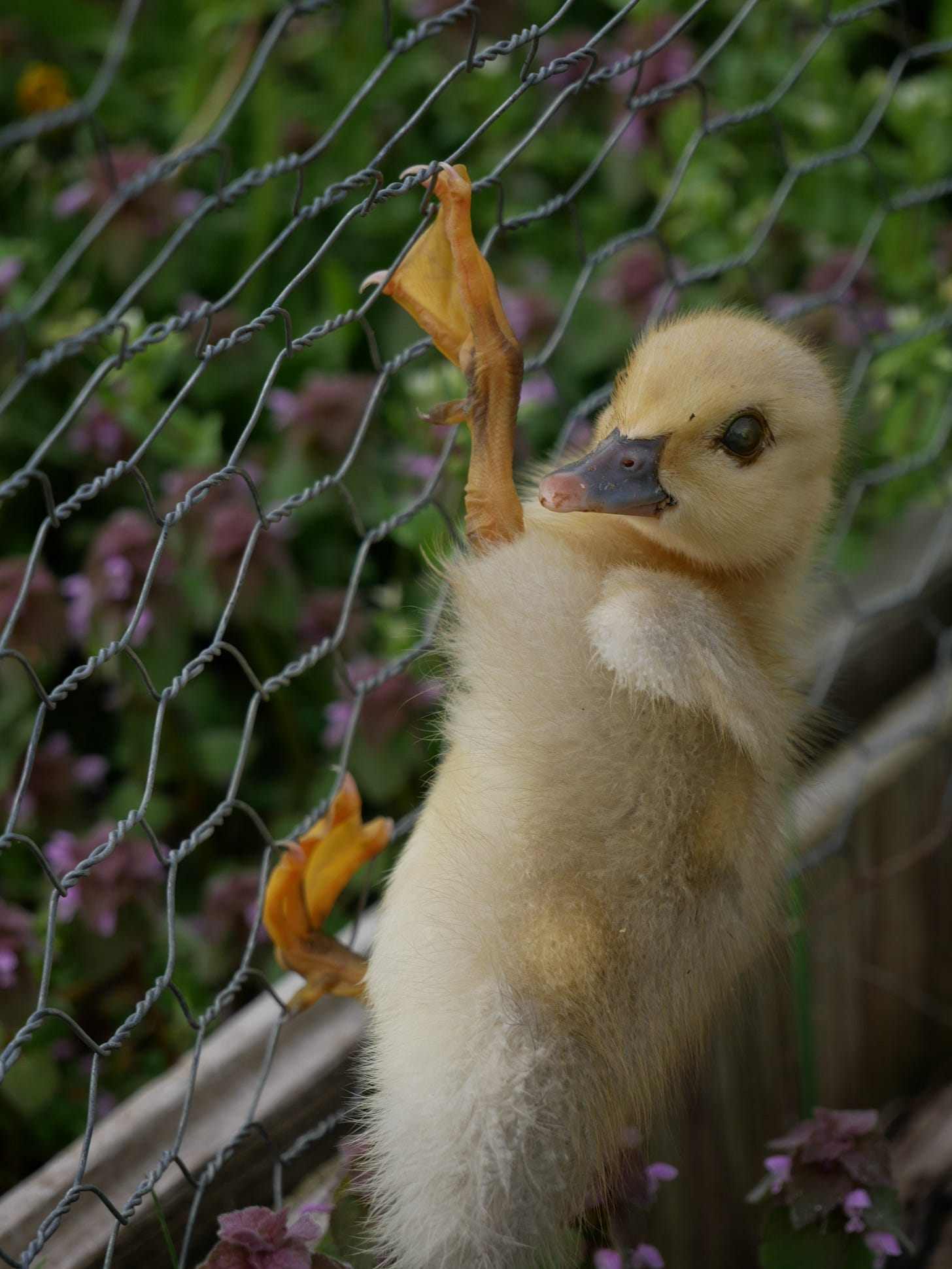
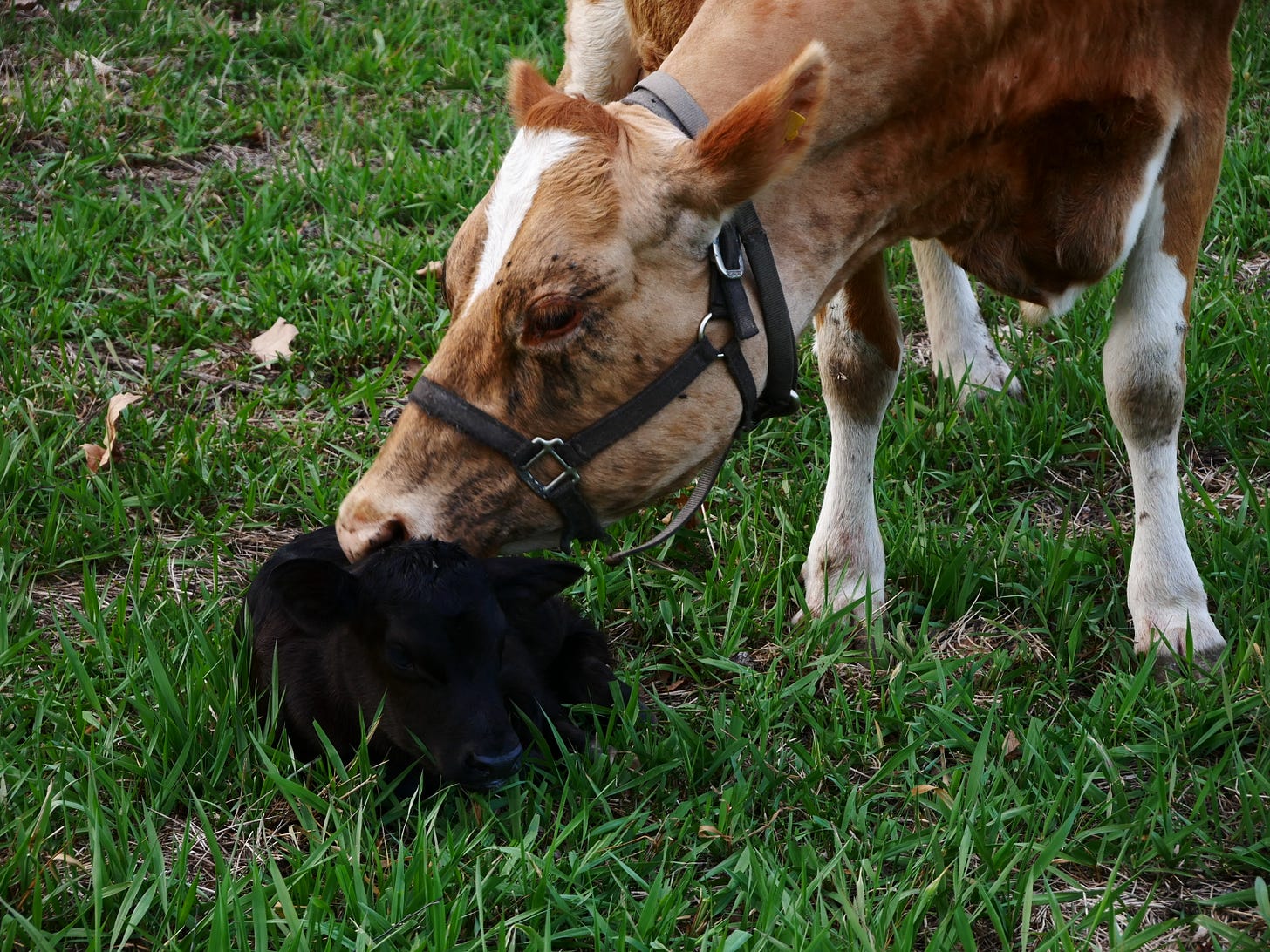
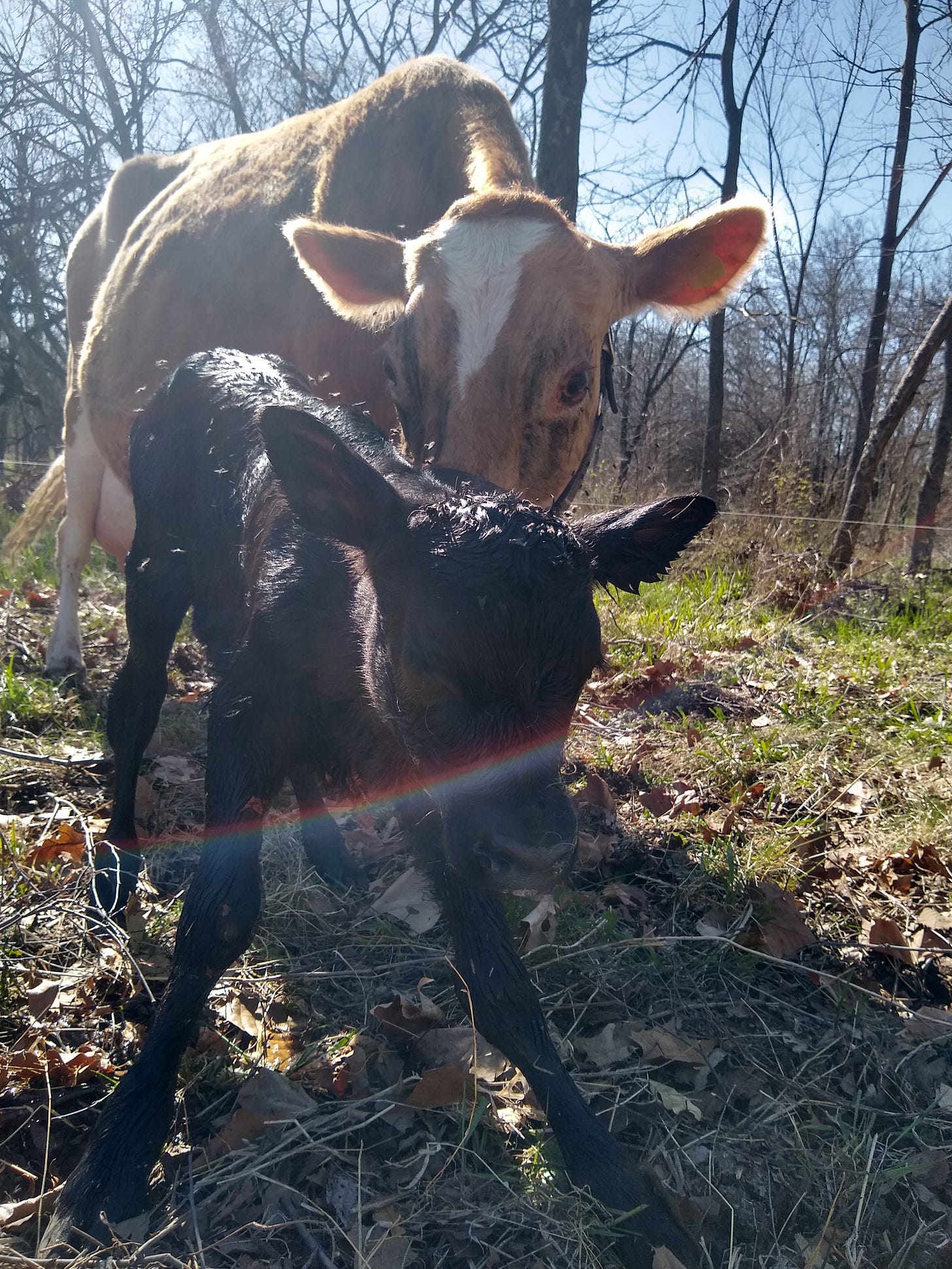
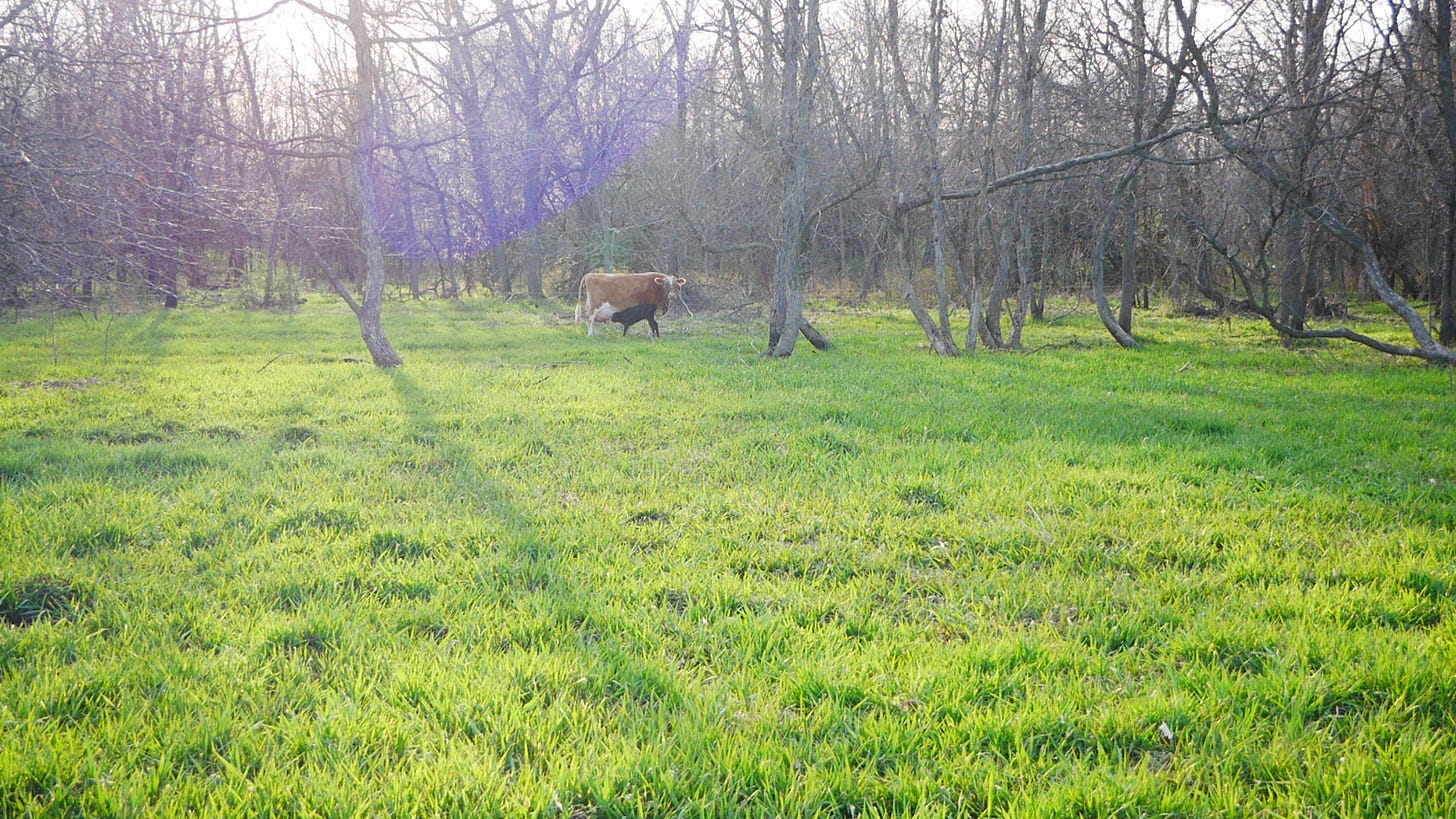
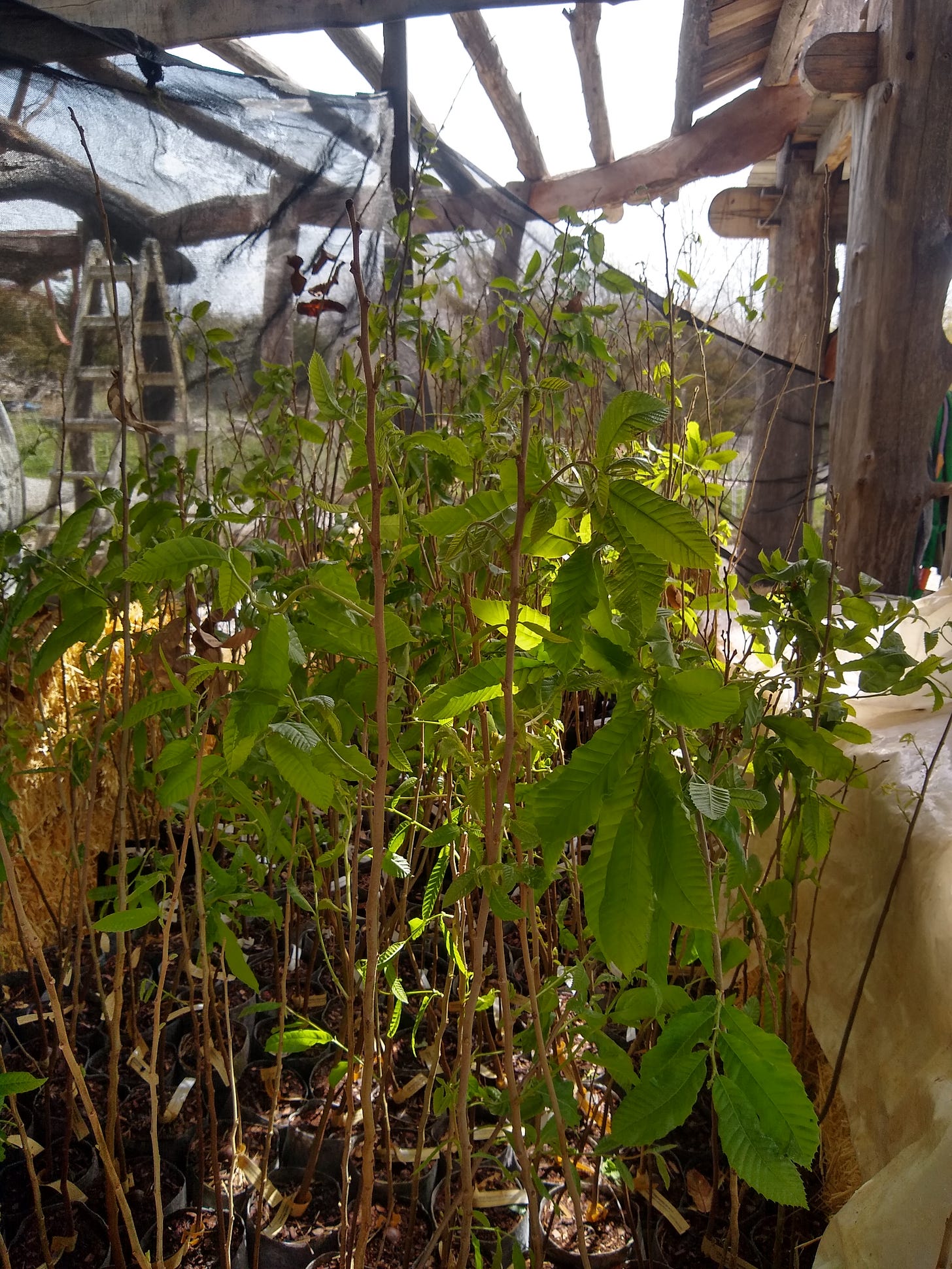
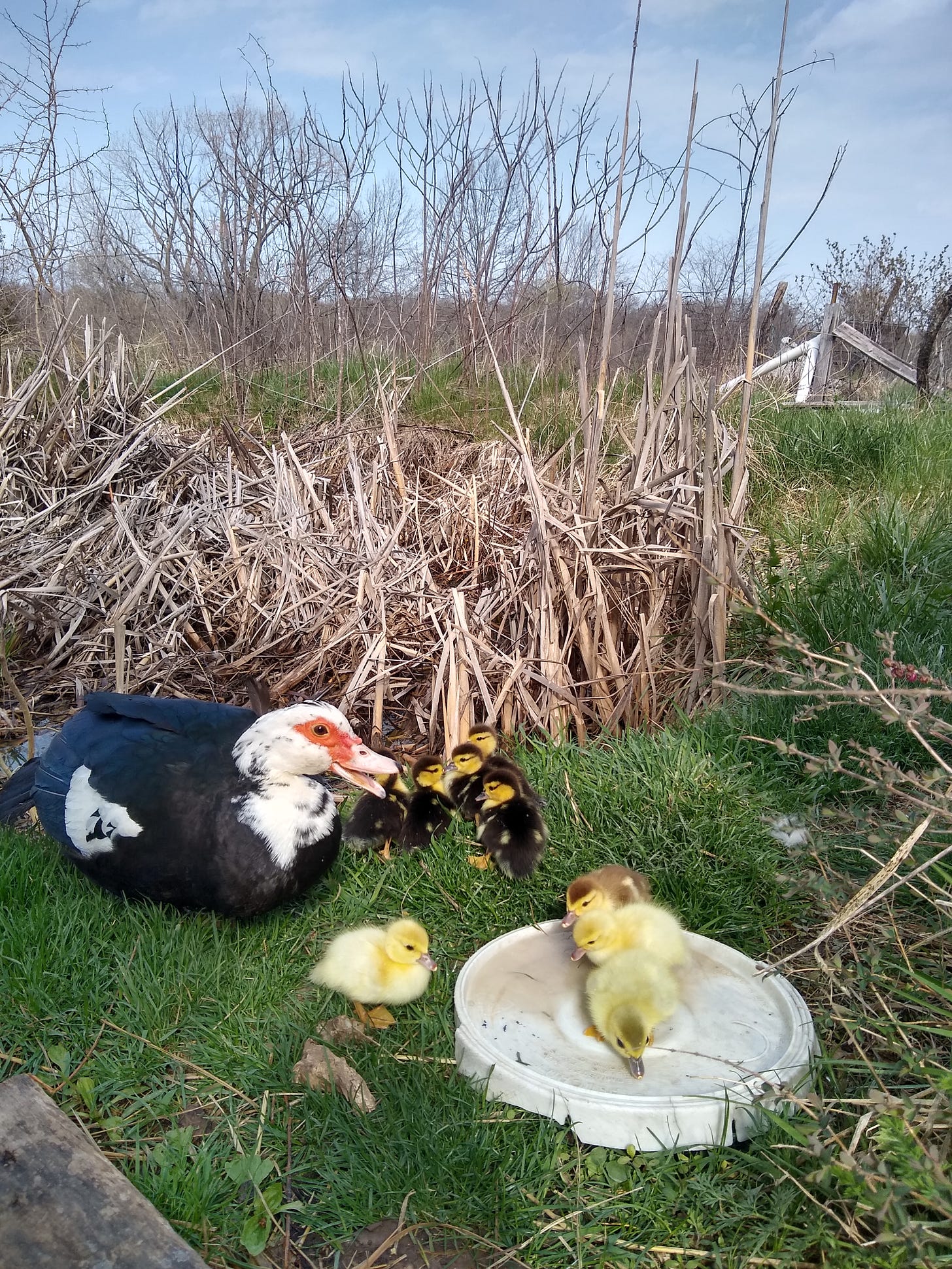
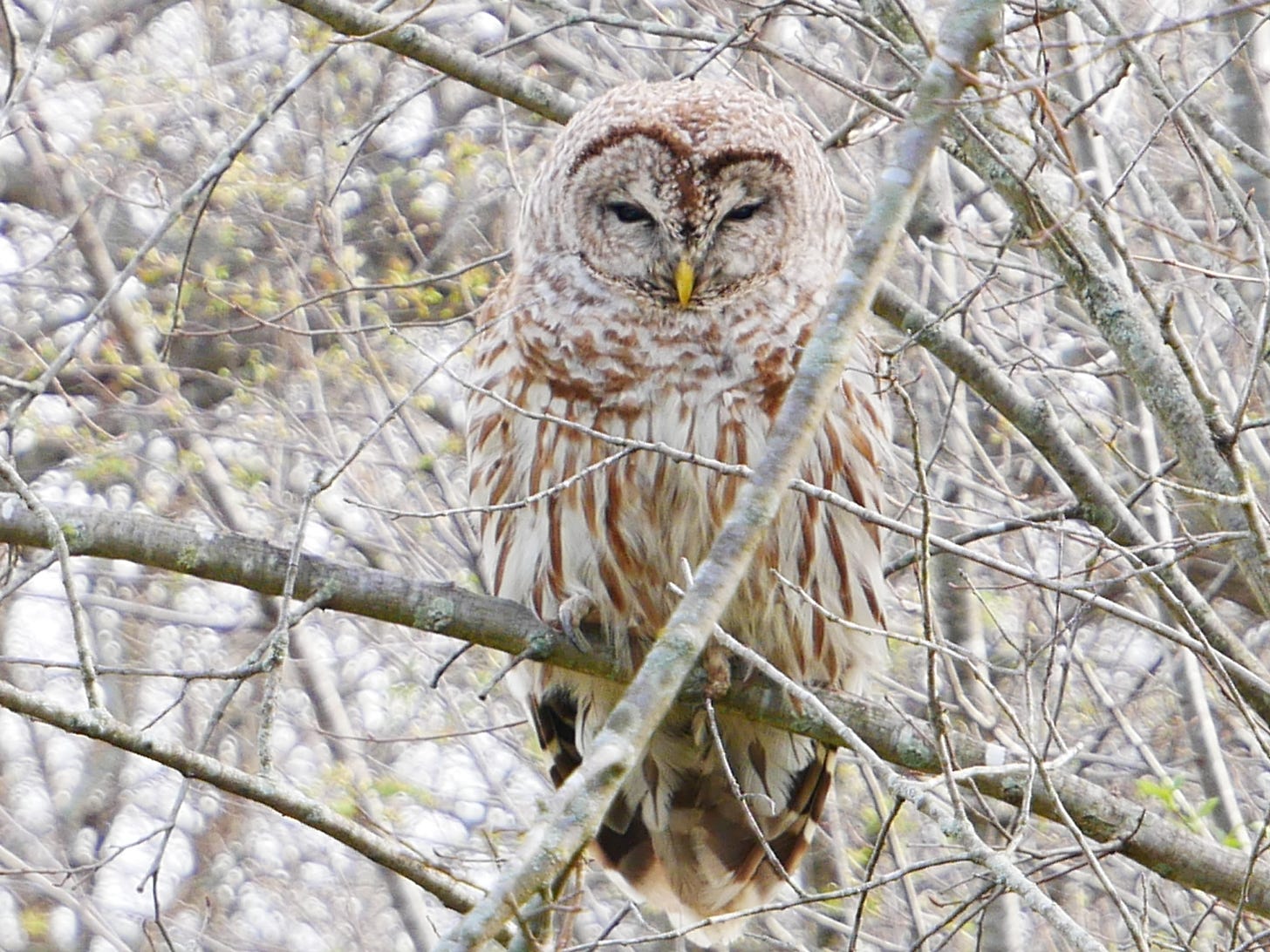
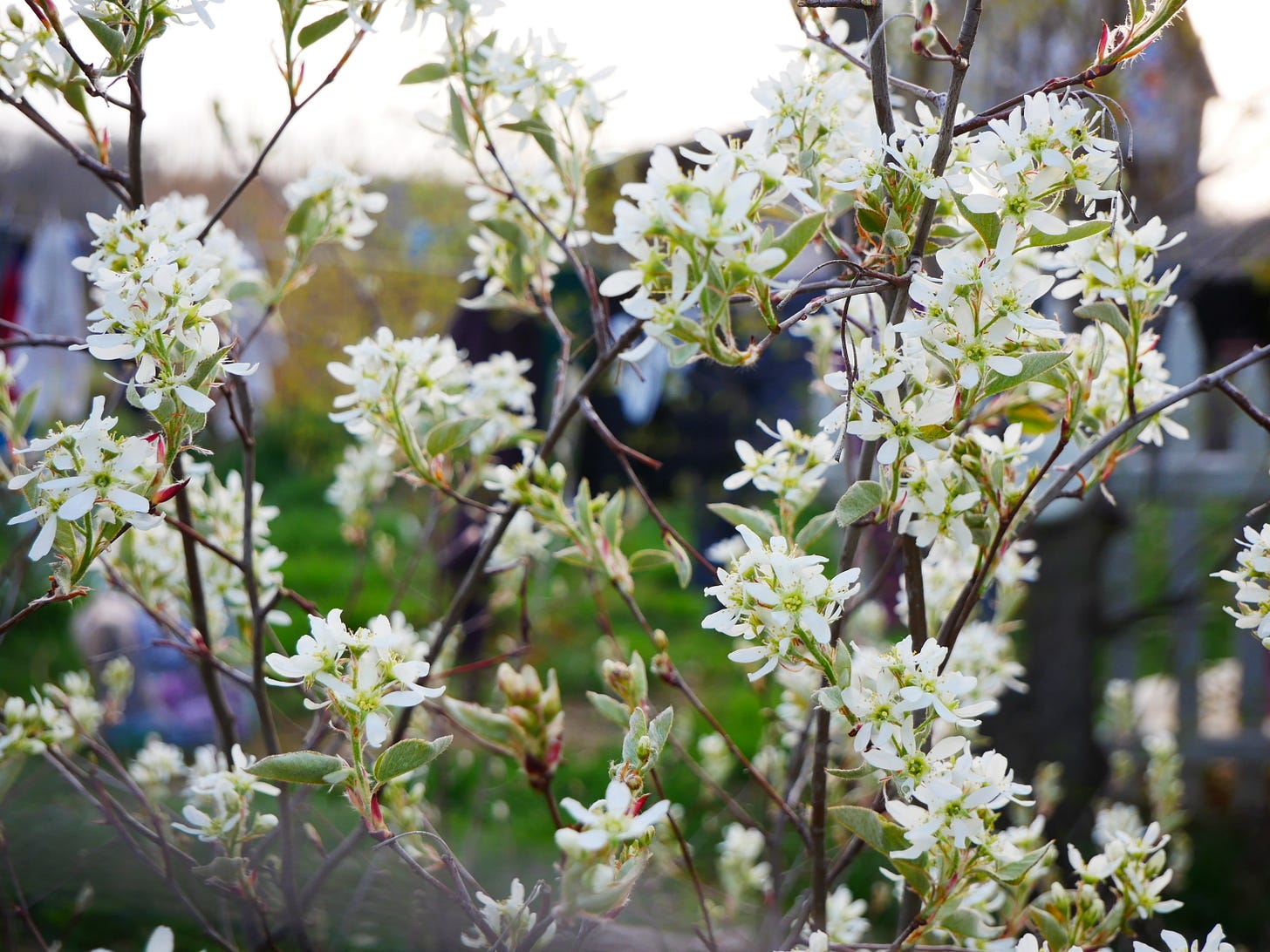
I am so grateful for your writing, Ben. These days I have not found as much time for reading but I'm so glad I read this one. You have an amazing heart that is revealed in your essays. Your strong gift with words brings tears of both heartbreak and love.
I am hopeful to get a visit to DR this summer and will be so happy to see what the Critters are working on, hopefully put in some helping hands, and get hugs that will sustain me until our next time together. Until then, I will check back for more insights as I make time for reading. And I'll send a little something along to hopefully help bring your book to life. Funny to find your Ko-fi fundraiser just after thinking, "Man, Ben needs to put out a book so more people can find his beauty and perspective that is so enriching and fulfilling."
Keep on loving and living in connection with Earth, Brother. You're helping us find our way. One essay, one calf, one duckling at a time, you help us find our own hearts... and share love in our own places.
See you soon.